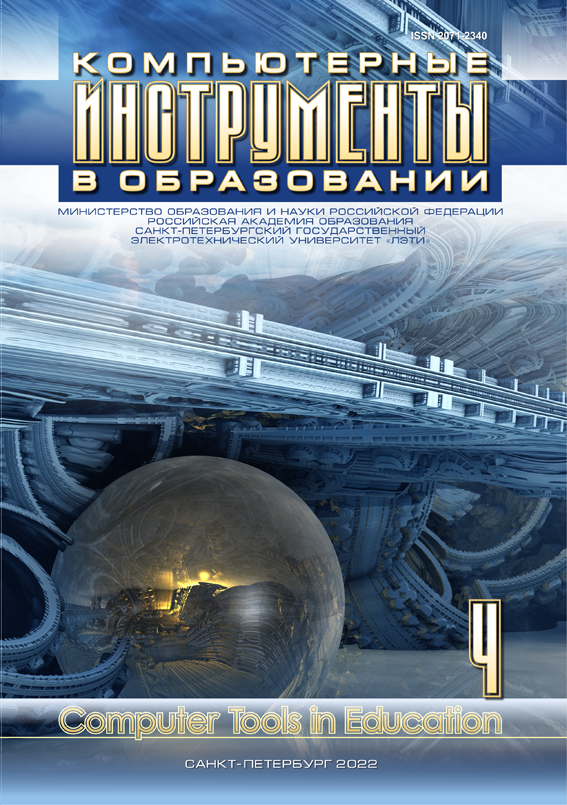Examples of Concepts Representations in the Main Content Lines of an Alternative Course of Mathematics in High School
Abstract
The article considers an example of building a course for correcting knowledge in mathematics obtained in high school when moving to a university. The purpose of the experiment is to introduce students to the university course of mathematics with a parallel repetition of those sections of school mathematics that determine the success of mastering the university program. The developed course implements the following methodological approach — the creation of integral teaching materials that combine various representations of mathematical concepts. The integrity of such teaching materials is manifested in the use of connections between mathematics and theoretical informatics, the connections of various sections of mathematics with each other using a variety of computer tools available to schoolchildren. The possibilities of dynamical geometry are analyzed and discussed in detail when the concept of derivative is introduced.
References
M. I. Bashmakov, S. N. Pozdnyakov, and N. A. Reznik, Learning Information Environment, St. Petersburg, Russia: Svet, 1997 (in Russian).
B. Senichenkov, “Virtual laboratories: use, development, standardization,” Computer tools in education, no. 3, pp. 108–132, 2022 (in Russian); doi:10.32603/2071-2340-2022-3-108-132
A. S. Chukhnov, “Constructive Tasks as a Tool of Invasive and Non-invasive Assessment of Knowledge,” Computer tools in education, no. 3, pp. 96–104, 2019; doi:10.32603/2071-2340-2019-3-96-104
S. Papert, Mindstorms: Children, Computers, and Powerful Ideas, Moscow: Pedagogika, 1989 (in Russian).
F. Adlaj and S. N. Pozdnyakov, “Digital Representations of Mathematical Objects in the Context of Various Forms of Representation of Mathematical Knowledge,” Computer tools in education, no. 1, pp. 58–86, 2020 (in Russian); doi:10.32603/2071-2340-2020-1-58-86
J. Dieudonne,ˊ Linear algebra and geometry, Moscow: Nauka, 1972 (in Russian).
V. Dubrovskii, “Visualization of Functional Dependences in Dynamic Geometry Systems,” Computer Tools in Education, no. 4, pp. 93–112, 2020 (in Russian); doi:10.32603/2071-2340-2020-4-93-112
M. I. Bashmakov, Mathematics: a textbook for early institutions and avg. prof. education, Moscow: Academia, 2013 (in Russian).
Yu. I. Ionin, The integral and its applications in schools and classes with in-depth study of mathematics, Diss. сandidate of pedagogical sciences, Moscow, 1975 (in Russian).
V. I. Ryzhik, “Computer: time for change,” Mathematics in School, no. 1, pp. 52–60, 2023 (in Russian); doi:10.47639/0130-9358_2023_1_52
V. Nuzov, “Interview of academician Vladimir Arnold for Seagull magazine,” Seagull magazine, no. 20 (127), 2008. [Online] (in Russian). Available: https://www.mccme.ru/edu/viarn/2008/chaika.htm
V. I. Arnold, “Ordinary differential equations,” Moscow: MCCME, 2012 (in Russian).
ANO KIO “Tasks from previous years,” in Computer Science Competition: Design, Explore, Optimize, 2023. [Online], (in Russian). Available: http://kio-nauka.ru/kio23/examples/go/p
V. I. Ryzhik, 25000 lessons of mathematics, teacher’s book, Moscow: Prosveshcheniye, 1993 (in Russian).
I. S. Berezin and N. P. Zhidkov, Calculation methods, vol. 1, Moscow: GIFML, 1962 (in Russian).
F. Ferrara, D. Pratt, and O. Robutti, “The role and uses of technologies for the teaching of algebra and calculus: ideas discussed at PME over the Last 30 years,” in Handbook of Research on the Psychology of Mathematics Education, Leiden, Nederland: Brill Publishers, pp. 237–273, 2006; doi:10.1163/9789087901127_010
D. Tall, “Concept images, generic organizers, computers & curriculum change,” For the Learning of Mathematics, vol. 9, no. 3, pp. 37–42, 1989.
I. Biza and T. Zachariades, “Using Dynamic Geometry to introduce Calculus concepts: CalGeo and the case of derivative,” Research in Mathematics Education, vol. 10, no. 1, pp. 89–90, 2008; doi:10.1080/14794800801916655
D. O. Tall, “Using Technology to Support an Embodied Approach to Learning Concepts in Mathematics,” Historia e Tecnologia no Ensino da Matematica, vol. 1, pp. 1–28, 2003.
S. V. Larin, Methods of teaching mathematics: computer animation in the Geogebra environment: textbook for universities, Moscow: Yurayt, 2023 (in Russian).
T. L. Ovsyannikova, “Using the GeoGebra environment in the study of the derivative,” Mir pedagogiki i psikhologii, no. 09(62), pp. 80–84, 2021 (in Russian).

This work is licensed under a Creative Commons Attribution 4.0 International License.







